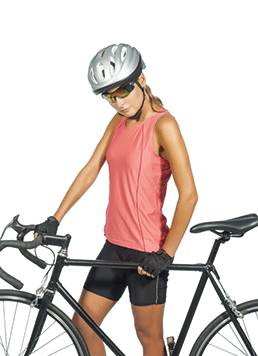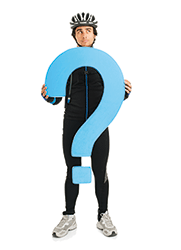On your bike

Cycling is a great way to keep fit and healthy and can be enjoyed by all the family. Here are our top tips for getting started
There’s nothing better than heading out for a bike ride on a sunny day with the family and a healthy picnic in tow. In fact, cycling can be enjoyed almost anywhere and at any time of the year and doesn’t have to cost a fortune.
There are numerous health benefits to be enjoyed through cycling, from increasing muscle tone and building stamina to improving your cardiovascular fitness and supporting your heart health. A bike ride can even help your mental health, reducing stress and promoting better sleep. Before you start out though, there are a few things to bear in mind, such as road safety and choosing the right bike and equipment.
Road safety
Whenever you cycle on the road, it’s vital that you obey the Highway Code and ride in a safe, responsible and respectful manner. Follow these basic points, provided by British Cycling’s Insight Zone (www.britishcycling.org.uk/knowledge) every time you head out.
Positioning in the road – An effective rider always occupies the moving traffic lane, either in its left hand third, roughly in line with the near-side of a car in the same place, thus ensuring that she/he can be seen and that drivers have to manoeuvre to overtake – or, if need be, the middle of the lane, thus preventing being overtaken and leaving themselves free to turn, overtake, change lanes etc. These riding positions are variously known as ‘normal’ and ‘taking the lane’ or, technically, ‘secondary’ and ‘primary’.
Ride predictably – Hold your line and position in the road. Do not weave from side to side.
Changing road position – If you need to change direction or change your position in the road, always look first to check it’s safe to do so and then, where applicable, make a clear signal to alert other road users and/or pedestrians of your intended action.
Obey road markings – Road markings apply equally to you as a cyclist as they would if you were in your car. Never cross solid white lines in the middle of the road and always obey stop lines at junctions.
Think ahead – Always try to look ahead down the road and anticipate any potential problems or dangers. If you know you need to change lanes or have a right turn approaching, look and move early.
Stay off the pavement – Unless clearly marked as a shared cycle/pedestrian lane, cycling on the pavement or any footpath is illegal and dangerous both for you and pedestrians. If you’re not confident to ride on the road, consider attending a Bikeability course.
Two hands on the bars – Unless signaling, always keep two hands on your bars and maintain a relaxed but firm grip.
Cover your brakes – Keep your hands in a position where you can easily and quickly operate your brake levers in a safe manner. Especially if riding in a group, avoid sudden braking and try to avoid locking up your wheels.
Obey traffic lights – Like all areas of the Highway Code, cyclists are required by law to obey all traffic signals. Stop at all red lights and remain behind the solid white stop line. There are sometimes marked boxes for cyclists but, if not, do not be tempted to creep forwards. Even if the way ahead, such as when turning left, appears to be clear, wait for the lights to turn to green before moving off.

Which bike should you choose?
Mountain bike
Mountain bikes have thick tyres and bouncy suspensions which are best suited to pavements, country lanes and off-roading. Find the lightest mountain bike you can afford with front suspension (a ‘hardtail’) and ask your local bike shop about the difference between a hardtail and full suspension mountain bike. Avoid disc brakes that are operated by cables but go for V-brakes – brake pads either side of your wheels. They’re much more reliable and you can replace them easily and cheaply.
Road bike
Road bikes or touring bikes are very lightweight and usually have thin tyres and drop-handlebars. They’re great for speed and long rides on tarmac. As the name suggests though, they’re not suitable for bumping along on single-track trails.
Essential equipment
Before you head out on the road, make sure you have these essential pieces of equipment with you:
Cycling helmet
Go to a bike shop with a good range and try on a few to make sure you find the right fit. Make sure your helmet has passed either the US Snell B90/B95 standard or European standard CE mark test. This can be found on a label inside the helmet with the relevant markings.
Inner tubes and patches
You don’t want to be trying to patch up an inner tube by the side of the road so always carry at least one spare tube that you can just swap in. You can patch the punctured tube up once you’re home. Make sure that the valve length is correct for the rims you’re riding and the tube is the correct width for your tyres.
Tyre levers
A pair of plastic tyre levers make getting a tight tyre off the rim to fix a flat far easier. Look for ones that are stiff, hook onto the spokes and that clip together. Avoid metal ones as they can easily damage your rims.
Pump/CO2 canister
Mini-pumps that also accommodate a CO2 canister are compact, give you instant inflation to rideable pressure, allow you to top up the tyre manually and, if you should use up all your canisters dealing with multiple punctures, you’ve still got the pump as a standby.
Multitool
A multitool should have a range of allen keys, screwdrivers and torx heads that will allow you to adjust all of the important bolts on your bike. Your handlebars, stem and seatpost clamps are the most likely candidates for tweaking. A multi-tool should also have a chain tool on it in case you break your chain.
Quick release chain link
Multitool chain tools are fine for removing links from broken chains but tend to be slightly hit or miss for rejoining them. A quick release chain link provides an easy solution. Check you have the correct model for your make of chain and try the release mechanism at home first as they can be a little fiddly until you get the knack.
Gilet/waterproof
Modern gilets and jackets fold down easily small enough to fit in a jersey pocket and even on scorching summer days are still a good idea to carry. It’s easy to get chilled when stopping to fix a flat or, on hilly or mountainous rides, on long descents.
Map
In these times of pre-plotted GPS routes and turn-by-turn navigation prompts it’s all too easy to ride blind with no real idea of where you are. Batteries can run out though and devices fail so it still pays to carry a paper map if you’re in an area you don’t know.
Advice provided by British Cycling’s Insight Zone. Visit www.britishcycling.org.uk/knowledge to find out more.
Read previous Your Outdoor Living articles here...